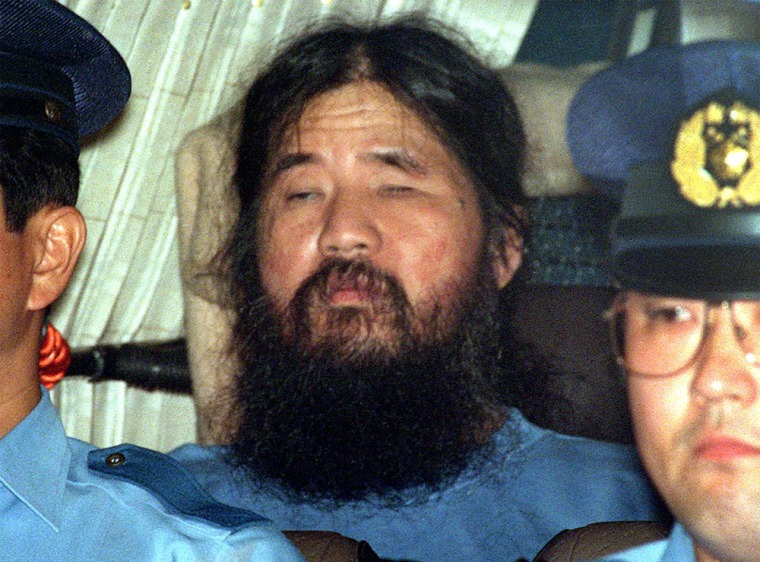Former doomsday cult guru Shoko Asahara was convicted and sentenced to death Friday for masterminding the deadly 1995 nerve gas attack on the Tokyo subway and a string of other crimes that killed 27 people, shocked Japan and alerted the world to the danger of high-tech terrorism.
Asahara, founder of the apocalyptic Aum Shinrikyo cult, also was convicted of ordering his followers to produce and stockpile arsenals of conventional and chemical weapons, including the sarin gas used in the subway attack.
Asahara stood in silence as the verdict -- guilty on all 13 counts against him -- and sentence were read. Asahara is the 12th person sentenced to hang for the attacks, and the decision was widely expected.
Appeals could last years
The former cult leader's attorneys immediately appealed, arguing that prosecutors had ignored testimony showing Asahara was not behind the crimes, said lead defense lawyer Osamu Watanabe. The move will set into motion further legal proceedings that some say could last another decade.
The ruling was the climax of a nearly eight-year-long trial. His attorneys had argued that Asahara -- whose real name is Chizuo Matsumoto -- had lost control over his flock by the time of the March 20, 1995, subway attack that killed 12 and sickened thousands.
The prosecution, however, depended on testimony from former followers who said that Asahara had planned and ordered their murderous deeds.
Asahara also was convicted of masterminding a sarin gas attack in June 1994 in the central Japan city of Matsumoto, the murder of anti-Aum lawyer Tsutsumi Sakamoto and his family, and the killings of wayward followers and people helping members leave the cult.
Thousands of members
At its height, Asahara claimed 10,000 followers in Japan and 30,000 in Russia. The guru used a mixture of Hinduism, Buddhism, Christianity and yoga to entice his devotees, who engaged in bizarre rituals such as drinking his blood and wearing electrical caps that they believed kept their brain waves in tune with their master.
Many terrorism experts also point to Aum's weapons program as an early indication of how individual groups, not only national governments, could use money and technology to compile arsenals of weapons of mass destruction.
The families of victims welcomed news that Asahara had been sentenced to the gallows.
"It was good to hear the death sentence that I had been hoping for," said Shizue Takahashi, widow of a train worker killed in the subway sarin attack. "I visited my husband's grave this morning and I came to hear the ruling with his spirit."
Some said that they were saddened that Asahara never acknowledged his responsibility for the crimes or apologized to the victims. He grinned and made comic faces during the proceedings, but barely spoke, only occasionally babbling incoherently in broken English.
"This death sentence is not enough," said Yoko Ito, whose daughter was killed in the Matsumoto gas attack. "I was hoping that he would say something, but it's very disappointing that the verdict ended in silence."
The verdict came after several hours of proceedings in which Judge Shoji Ogawa detailed the 13 counts against Asahara and dismissed the former guru's claims of innocence.
"The defendant plotted to spread sarin nerve gas across Tokyo, destroy the capital and build his own kingdom, and he ordered the construction of a sarin production plant," Ogawa said.
There are no jury trials in Japan, and a four-judge panel led by Ogawa delivered the verdict and sentence.
Tight security
Security was tight at Tokyo District Court to guard against disruptions by Asahara followers, and media reported that a decoy was used on the way to the court Friday morning to thwart any attempt to free the ex-guru. Some 4,600 people turned out for a shot at the 38 courtroom seats available to the public; spectators were chosen by lottery.
"I can't think of any other sentence but death for Asahara," said Yasutomo Kusakai, a 22-year-old college student who tried unsuccessfully to get a courtroom seat. "Many people were killed, and he's supposed to be the mastermind of the crimes that affected the society in a big way."
The subway gassing was Aum's most horrific crime. Five cult members pierced bags of sarin -- originally developed by the Nazis -- on separate trains as they converged in central Tokyo's national government district as a pre-emptive strike against police planning raids on the cult.
The attack sent the country into a panic as sickened, bleeding passengers stumbled from subway stations.
Survivors still suffer from headaches, breathing troubles and dizziness. The cult was ordered in separate court proceedings to pay 3.8 billion yen, or US$35 million, in damages to the victims.
Aum's weapons program was carried out by a coterie of highly educated scientists from Japan's best schools. Asahara's flock was bewitched by his predictions of an Armageddon that only cult members would survive.
Long trial
The trial was lengthened by Japan's chronic shortage of lawyers and judges, the complexity of the case and a six-month delay caused by Asahara's firing of his first attorney. Friday's session was the 257th of the trial.
Police say the cult's remnants -- renamed Aleph since 2000 -- are showing signs of greater allegiance to Asahara. Agents this month raided the offices of the group, which still claims 1,650 members in Japan and 300 in Russia.
The group released a statement after the verdict, apologizing to the families of the victims of Aum's crimes and vowing to compensate them.
